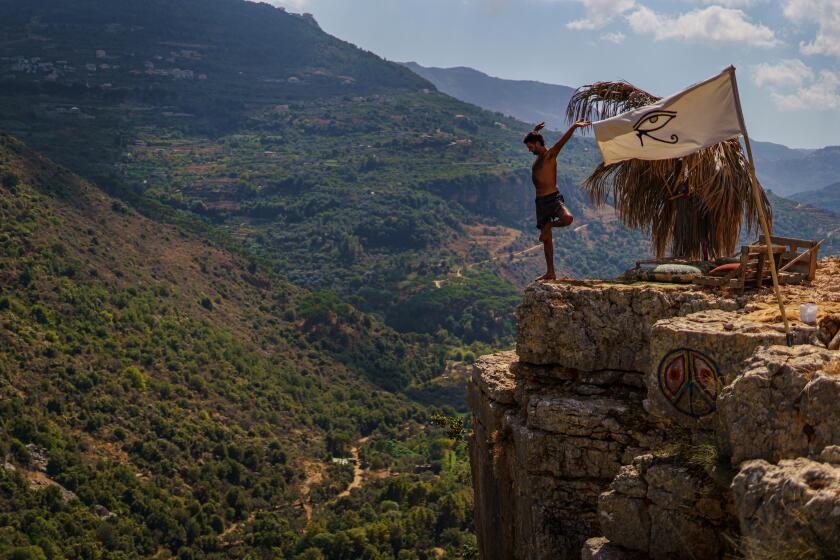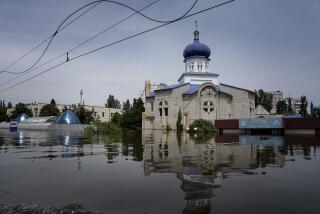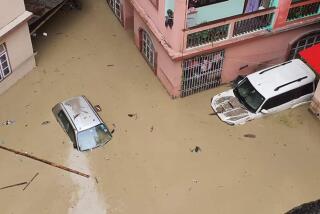Crisis in the Himalayas: Climate change and unsustainable development
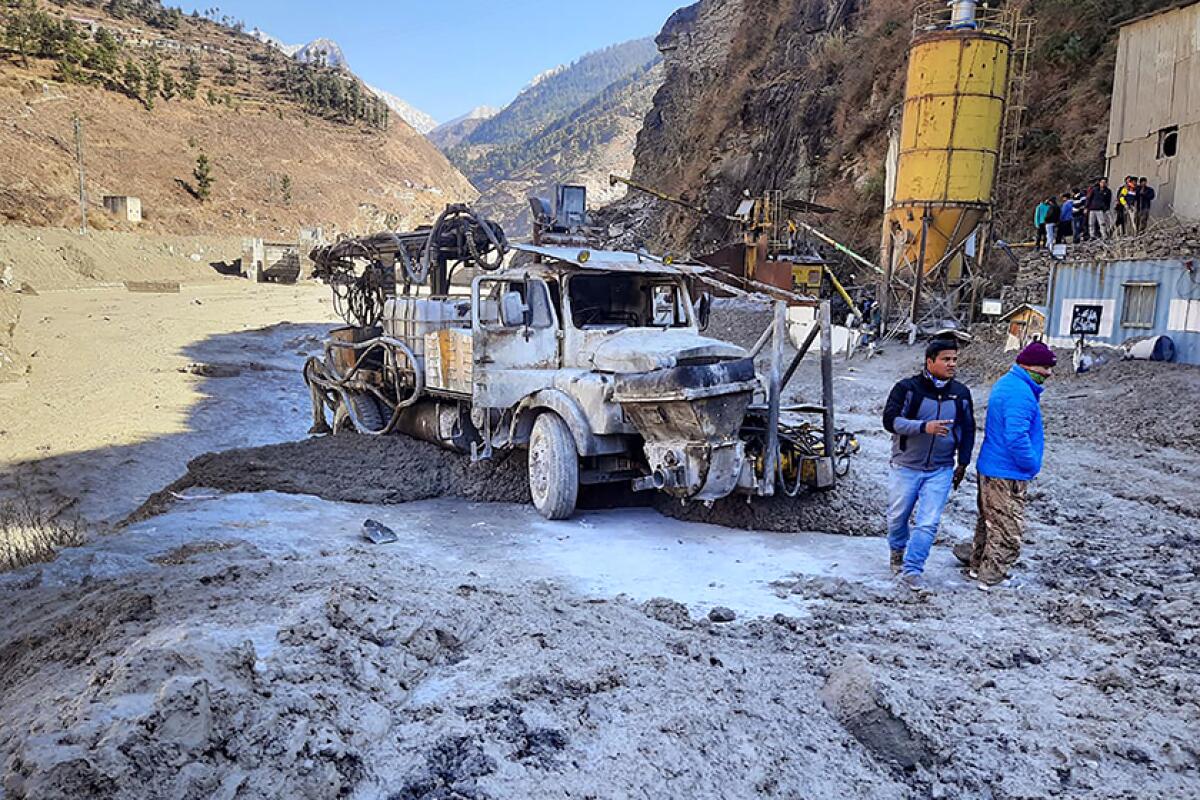
- Share via
JOSHIMATH, India — Tending his fields one crisp winter morning, Chandra Singh Rana saw what looked like smoke emerging from the wooded slopes and snow-capped peaks that led to Nanda Devi, one of the world’s tallest mountains.
The accompanying roar sent the 77-year-old, his grandson and fellow residents of Reni, a village nestled up in the Indian Himalayas, scrambling for higher ground. A rockslide in the nearby mountains triggered a tsunami of water, stones and mud that hurtled through the steep river valley dividing the village, consuming those unable to escape.
The torrent traveled downriver, picking up pace as it tore through a bridge and two hydropower plants, nine and 15 miles away from the rockslide. More than 200 people are believed to have been consumed by the lethal sludge. Most of the bodies are missing somewhere in the gray crater it left behind.
“It had never happened in my life,” said Rana. “It should not happen again. God saved us.”
The disaster last month has brought into focus what locals and scientists say is a crisis unfolding in the Himalayas, the world’s tallest mountain range.
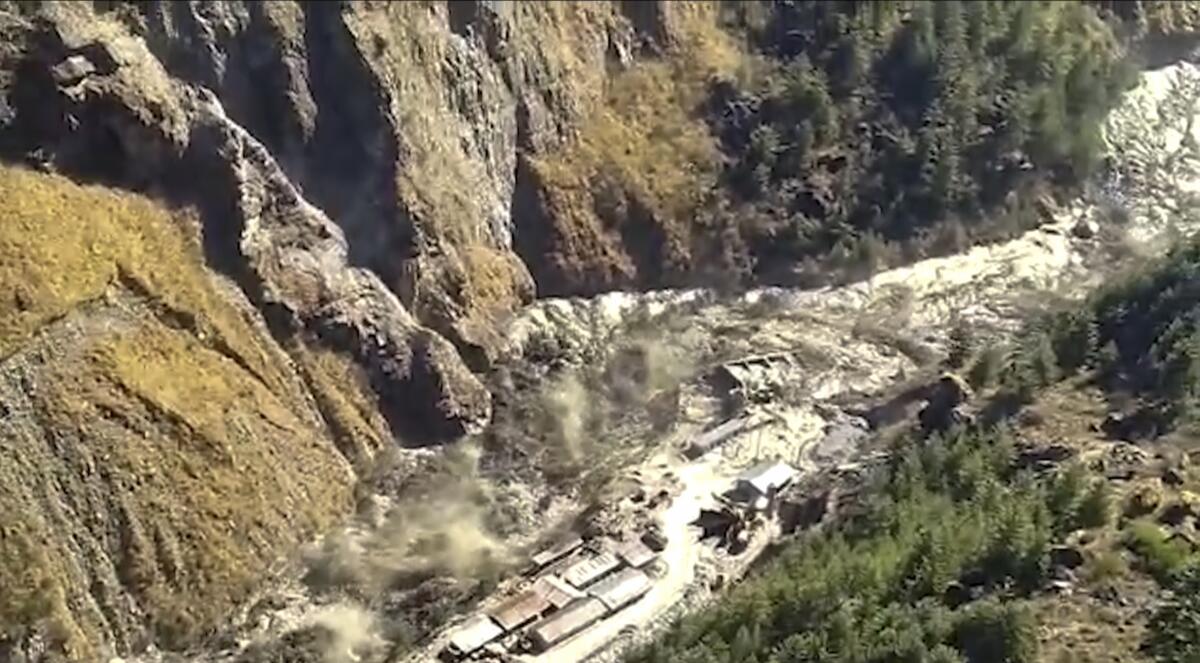
They say an explosive cocktail of climate change and aggressive road and dam building in the geologically unstable range threatens not just villages like Reni but the people, economies and security of the eight countries in the greater Hindu Kush Himalayan region.
The mountains run from Afghanistan in the west to Myanmar in the east, forming the backbones of countries including India, China and Pakistan. Rivers like the Ganges, Indus and the Yarlung Tsangpo (also known as the Brahmaputra) sustain more than 1.5 billion people and industries powering some of the world’s fastest economic growth. They also traverse the world’s most volatile geopolitical fault lines.

Climate change is amplifying the dangers. Temperatures in the Himalayas have risen faster than in other mountain ranges, according to Maharaj Pandit, a professor of environmental studies at the University of Delhi. The International Center for Integrated Mountain Development (ICIMOD), a regional intergovernmental body, says the region will warm above the global average.
India’s recent deadly flash flood was a combination of “geological activities … the effects of climate change, as well as the unsustainable infrastructure development that has accelerated the process,” said Pema Gyamtsho, ICIMOD’s director-general and a Bhutanese politician. “We know the Himalayan region is very vulnerable, but we’re not taking that into consideration.”
Precarious ecosystem
That Reni — of all the hundreds of settlements carved into the steep mountainous slopes of the Indian state of Uttarakhand — was struck by the flood is one of history’s tragic ironies.
It was this village that helped to spawn the Chipko ecological movement, when local women fended off loggers in 1974 to stop a nearby forest from being razed. The Chipko protests inspired modern environmental activism in India.
Roaring economic growth has in the decades since brought a frenzy of activity to India’s Himalayan states, home to 80 million people. Towns, including mountainous slums, have swelled in size. Contractors felled forests, cut into mountain slopes and dug tunnels in order to make way for more houses, roads and dams.
The many consequences of climate change on this precarious ecosystem are still being understood. But scientists estimate that Himalayan glaciers will recede by a third by 2100 if the increase in global temperatures is capped at 1.5 Celsius — the most ambitious target — with losses far higher if the target is missed.
More than 1 billion people “rely on the waters coming from the Himalayas,” said Izabella Koziell of the International Water Management Institute in Sri Lanka. “It can mean increased flooding. It can mean more variable water flows…. If they start melting fast, you just have less water. Then the implications are massive.”
The government says a dam is necessary to provide drinking water in an era of rising temperatures and climate change. Activists say it’s another corrupt government project.
The recent tragedy encapsulated the potent mix of natural and human-made dangers.
According to ICIMOD, the rockslide on a nearby mountain melted the ice and snow in its way, smashing through two hydropower plants in its path: the Rishi Ganga plant, near Reni, and the under-construction Tapovan Vishnugad farther downriver. Their presence multiplied the economic and human toll, their workers accounting for many of the deaths.
Weeks after the disaster, Reni’s residents gathered as a priest led death rites for Amrita Devi, a 78-year-old who was lost in the torrent while tending her fields.
“We are from the village that taught the world about the importance of the environment,” said Hira Singh, a 38-year-old in attendance. “It’s very hard to start a normal life after this.”
Hydropower boom
Jawaharlal Nehru, independent India’s first prime minister, captured the centrality of dams to his vision for the country by calling them “temples of modern India.”
The Himalayan rivers have been a rich source of energy to nations on the mountain slopes. Pandit estimates that 1,300 hydropower plants have been built or planned across the region, with the Chinese developing 750 in Tibet alone.
Already the world’s third-largest emitter, India’s energy demand is set to grow faster than any other country in the next two decades. Ensuring this added demand is met with sources other than oil and coal is vital to global efforts to reduce emissions. Prime Minister Narendra Modi wants to expand renewable energy capacity to 450 gigawatts in the next decade.
The extent to which hydropower should be part of India’s plans is a source of fierce debate. For supporters, it is vital to fill in for the more variable electricity supply coming from solar and wind.
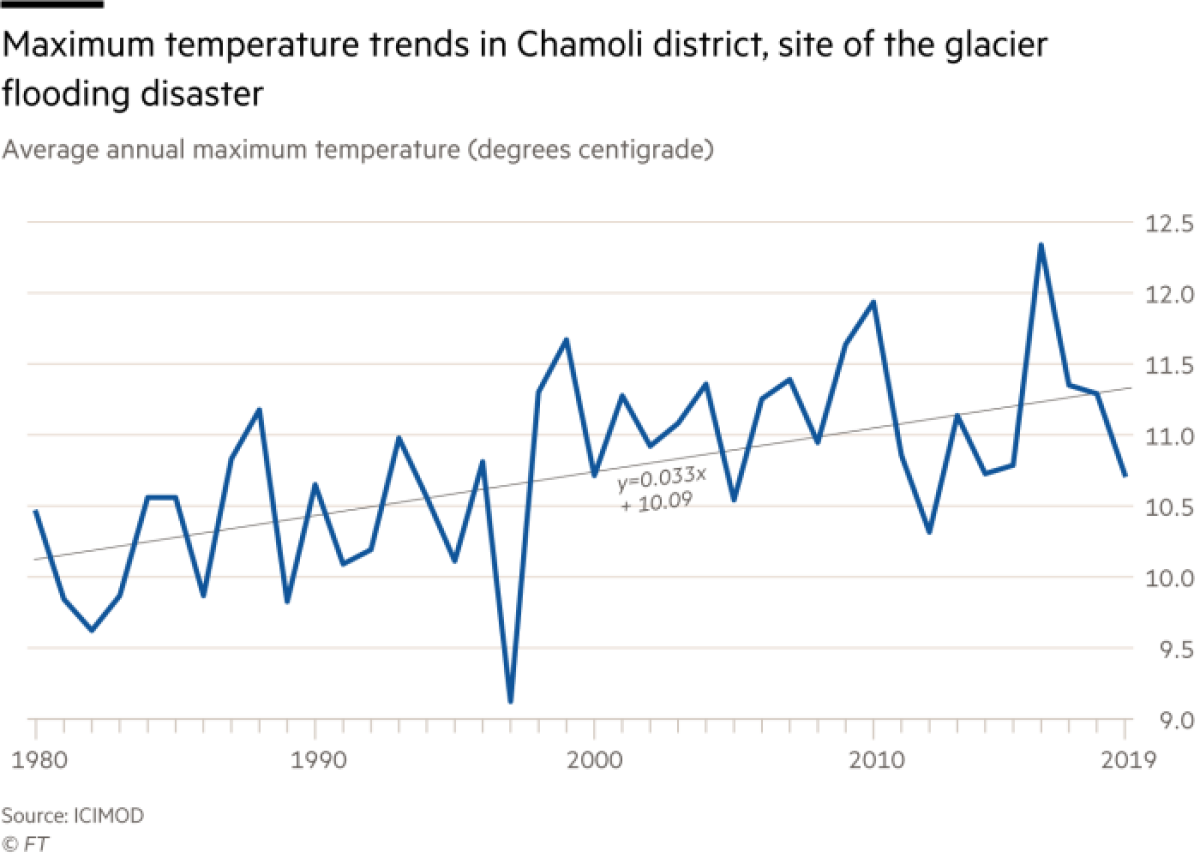
“That flexibility is very crucial to the long-term move of India in a green energy space,” said Harsh Shah, chief executive of IndiGrid, an investment trust backed by KKR & Co. that owns transmission lines transporting power from Himalayan plants. “Hydro is critical in India’s renewable energy mission.”
But their rampant construction in seismically active mountains has proved controversial. Later in his life, Nehru appeared to sour on such mega-projects. After a flooding disaster in Uttarakhand in 2013 killed about 6,000 people, a Supreme Court-appointed committee found hydropower dams aggravated the disaster and warned against construction in fragile, high-altitude areas.
Authorities are “playing with nature more than they should be doing,” said Vibhuti Garg at the US-based Institute for Energy Economics and Financial Analysis. “We don’t have to go very, very aggressive and build so many plants.”
The share of hydropower in India’s electricity mix has actually fallen from 23% in 2000 to 12%, with the price of other sources like solar falling sharply. Critics argue that what continues to drive the frenetic construction of hydropower plants is not energy security but the revenue they bring to local governments and developers.
“These people are some of the world’s poorest in terms of access to infrastructure…. You need to have a school, you need to have a health center,” said Anjal Prakash at the Indian School of Business in Hyderabad. “We need to close those projects and reorient, rethink where the investment is going.”
Road building has proved similarly controversial. India is building a 500-mile project known as the Char Dham Highway, linking several Hindu pilgrimage sites in Uttarakhand.
Authorities say the project, which involves widening narrow mountain roads to about 30 feet, will bring pilgrims, tourists and economic benefits, while allowing ready military access to India’s border with China.
But Ravi Chopra, an environmentalist who led a Supreme Court-appointed committee examining the project, said the tree-cutting required exacerbates dangers like landslides. He added that the project contradicts previous road ministry guidelines against such wide mountainous roads.
Atul Sati, a political and environmental activist in Joshimath, a town near the site of last month’s tragedy, said officials are imposing a model of development on the region that does not work.
“We need good roads. We don’t need two, three, four, five-lane highways,” he said. “Every time [a new hydropower project was built], we raised our voice that it was not safe…. We don’t learn our lessons.”
Fraught geopolitics
Last year, thousands of Chinese and Indian soldiers converged on the crystal blue lakes and barren crags of Ladakh, an inhospitable high-altitude desert. Tension over the contested border separating the nuclear-armed neighbors sparked deadly clashes, and one Indian commander said the countries came to the brink of war.
Some of the world’s most combustible geopolitical boundaries run through the mountains, from India and China’s 2,000-mile border to the Line of Control separating India and Pakistan in Kashmir.
Relations between these neighbors are tense at the best of times, and scientists fear this will only increase as population and economic growth — along with climate change — intensify the competition for shared resources like water from Himalayan rivers.
“One of the tragedies has been that climate and environmental issues have increasingly been dragged into the fraught geopolitics of the region,” said Aditya Valiathan Pillai of the Center for Policy Research in New Delhi. The countries should develop “a long-term, pragmatic, apolitical tract on civilizational survival.”
The eight Himalayan nations last year signed an agreement to work together on climate action. But many say co-operation and data sharing on issues like river flows are hampered by strategic concerns and paranoia.
Dipak Gyawali, Nepal’s former water resources minister, said climate change is treated as a remote threat. “For an average politician in the global south, there are too many here-to-here and now-to-now problems,” he said. “Climate change is just too far away on the horizon to matter.”
Many Himalayan nations suffer chronic water shortages. While the U.S. has nearly 2.3 million gallons a year of renewable freshwater resources per person, China has 528,000, India 264,000 and Pakistan less than 79,000, according to the World Bank.
Demand for water to sustain growing cities, agriculture and industry increases the strain on rivers snaking across these volatile borders.
The 60-year-old Indus Waters Treaty, regulating India and Pakistan’s shared use of the Indus River, is a long-surviving example of co-operation. But India, the upstream nation, has threatened to divert water when military tensions rise, most recently in 2019.
China has no water sharing treaties with its Himalayan neighbors. After border tensions with India in 2017, it flexed its muscles by temporarily halting data sharing for the flood-prone Brahmaputra river, which flows from Tibet into northeast India and Bangladesh.
Chinese dam-building on the Brahmaputra has further fueled alarm in India, which sees it as a potential way to control flows. China’s latest proposal to build more hydropower dams on the Brahmaputra, closer to the Indian border, risks adding to this mistrust.
“It’s only likely to be a worsening point of tension,” said Kyle Gardner of US advisory firm McLarty Associates, and author of a book on the India-China border. “I don’t think either side sees much reason to co-operate. China has the upper hand, literally. So the incentive, from a practical, realist international relations perspective, is pretty low.”
Investment push
In India, Modi’s government has sought to take a leading role in the fight against climate change. It is reportedly considering an ambitious net-zero emissions target by the middle of the century.
It also presents itself as a custodian of the country’s rich ecology. But activists fear that it is moving more aggressively ahead with destructive environmental policies to spur private investment, attract foreign companies and bring India out of the severe economic slump caused by the COVID-19 pandemic.
This includes opening up sensitive and protected lands for industrial use. The government last year unveiled proposed changes to the environmental impact assessments process required for infrastructure projects that reduce the role of public and independent expert input.
Critics say this erosion of standards is accompanied by shrinking space for dissent, including on environmental issues.
Authorities last month sparked international condemnation after arresting 22-year-old climate activist Disha Ravi, part of Greta Thunberg’s Fridays for Future movement, in connection with recent farmer protests. They accused her of sedition.
Previously “anyone who opposed [projects] would be labeled anti-development,” said Manshi Asher of the Himalayan environmental collective Himdhara. “But now if you say anything you’re anti-India.”
The residents of Reni, traumatized by their ordeal, have ceased fighting to preserve their environment. Their only remaining demand is that they be relocated altogether, lest a new disaster claim more of the village.
“We never wanted to leave this place. But because of the disaster there’s nothing we can do,” said Bali Devi, a 72-year-old who was part of the Chipko protests. “Anything can happen here. We never know.”
© The Financial Times Ltd. 2021. All rights reserved. FT and Financial Times are trademarks of the Financial Times Ltd. Not to be redistributed, copied or modified in any way.
More to Read
Sign up for Essential California
The most important California stories and recommendations in your inbox every morning.
You may occasionally receive promotional content from the Los Angeles Times.
